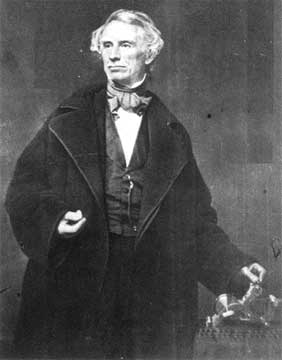1844 Inter-City Telegraph Communications Begins

Samuel Morse
The first inter-city telegraph was demonstrated by Samuel Morse. A telegraph line had been built for $30,000 dollars between Washington and Baltimore. The telegraph was to open a new era of communication in the world.
Rapid communication was an urgent necessity for a country the size of the expanding United States. Battles had been fought, and men had died because the leadership on their side did not know that the war was over (i.e. the Battle of New Orleans). Until the 1830’s the fastest way of spreading any message was via a man on horseback. In the 1830’s the railroads began to provide a faster means of communication. However, building a railroad was a slow, arduous task. As a result, transport, and thus the spread of news remained far from instant. Europe and France had deployed what was known as an "optical telegraph"--- a system made up of a series of towers with telescopes deployed every 12 or so miles to transmit information.
Inventors in the United States searched for a better way to transfer information. This task fell on Professor Samuel Morse. Morse was the son of minister and geographer Jedediah Morse. Morse had been known for his portrait painting, and for being the founder of the National Academy of Design. Morse turned his attention to developing an electric telegraph. A number of inventions had already been created that made the development of an electric telegraph possible. First, Alessandro Volta developed the electric battery in 1800. William Sturgeon developed the electromagnet in 1824. Then, Joseph Henry developed a method to strengthen an electro-magnet in such away to allow the transmission of a signal over a long distance.
Morse based his work on those who came before him. In 1837 Morse demonstrated he could transmit a signal ten miles through copper wires. Morse then developed what is known today as "Morse code", (a code that translates a series of varying long vs. short transmissions to represent different letter of the alphabet.) Words would be converted into Morse code ("dots and dashes) at the sending side and back to words on the receiving end.
Morse believed that the government should own communication lines. Furthermore, Morse wanted the government to build these lines. Morse worked to get the Congress to pass an allocation to build a telegraph line. Receiving governmental approval for telegraph lines would take a great deal of effort, (including giving the head of the Congressional Commerce Committee stock in his company.) Finally in 1843, Congress allocated money to build a telegraph line between Baltimore and Washington. On May 24 1844, Morse demonstrated the telegraph from the chamber of the Supreme Court in Washington to Baltimore. Morse sent the famous words "What Hath God Wrought" from the Supreme Court chamber.
Morse continued to believe that the federal government should build the telegraph nationwide. Morse also felt strongly that the telegraph should be part of the post office. However, once President Polk (who was opposed to any Federal involvement in internal improvement) won the election of 1844, it was clear that telegraphs would have to be built by private companies. Built it would be, and in a short period the telegraph tansformed the world and issued in the information age. Over the next 150 years the amount of data that could be transmitted increased, but the speed of data was established with the telegraph. With two decades of Morse's invention information could be transmitted nearly instantely to almost any corner of the earth..
 >
>